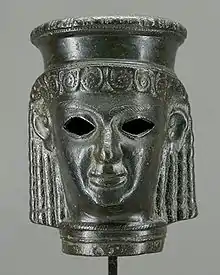Polos
The polos crown (plural poloi; Greek: πόλος) is a high cylindrical crown worn by mythological goddesses of the Ancient Near East and Anatolia and adopted by the ancient Greeks for imaging the mother goddesses Rhea and Cybele and Hera.[1][2]

The word also meant an axis or pivot and is cognate with the English, 'pole'. It was often open at the top with hair cascading down from the sides, or it could be reduced to a ring.[3]
In the classical period, mortal women seem not to have worn poloi, but they are more commonly seen in terracotta statues of women from the Mycenaean period, thus the use in statues of goddesses can be seen as a deliberate archaism.[3]
Some poloi seem to have been made by weaving though it is not clear what material. None have been found in archaeological digs,[3] suggesting that they were not made of metal.
Indian women in Rajasthan still wear those kind of rings made of cotton on their head to easily transport heavy pots of water.
Notes
- Liddell and Scott define πόλος as 'a head-dress worn by goddesses.'
- Assaf Yasur-Landau; Jennie R. Ebeling; Laura B. Mazow (10 May 2011). Household Archaeology in Ancient Israel and Beyond. BRILL. pp. 192–. ISBN 90-04-20625-6.
- The Role of Women in the Art of Ancient Greece Archived 2010-10-05 at the Wayback Machine